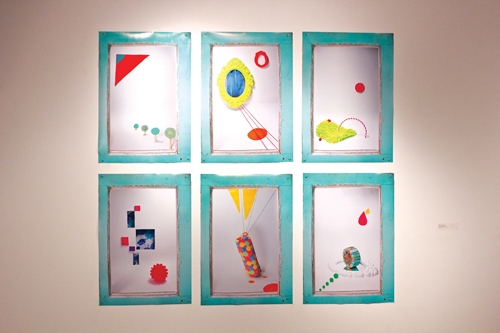The Visual Arts Student’s Association is holding its fifth annual juried art show, Sign/Signify
John Nyman
Senior staff writer
@excalweb

This month, York’s visual arts students are taking a step into the big leagues, presenting some of their best projects downtown in the Visual Arts Student’s Association’s annual juried exhibition, Sign/Signify.
Now in its fifth annual iteration, VASA’s “main event,” according to co-vice president Amanda Boulos, collects some of the most exciting pieces by York visual art BFA students in a variety of mediums. This year’s exhibition is especially diverse, including artworks ranging from Betty Zhang’s “Senbazuru,” a ceiling-to-floor origami installation themed around paper cranes, to Nicole Clouston’s “AK-47,” a solid steel replica of the infamous weapon built from scrap metal.
By bringing these works to the Artscape Triangle Gallery just across from the Drake Hotel, VASA hopes to expose York artists to the broader professional community in Toronto’s Queen Street West neighbourhood.
“One of our goals as VASA is to help students out with their future professional practice,” says Laura Huddart, co-vice president of the association.
VASA has also held events such as an artist talk with York’s MFA students, a workshop at Zacks Gallery last month, and a series of social events for visual arts students. They are also involved in the annual visual arts open house, which is being held this year on March 14 in the fine arts buildings.
One unique aspect of VASA’s selection process for Sign/Signify is its emphasis on strengthening ties between the most engaged visual arts students. The oeuvres were chosen by a student jury assembled by VASA from students they recognized as active and insightful participants in their classes. The goal is to establish friendships and professional connections as York artists further their careers beyond graduation.
“It’s good to create a community,” Boulos says.
For many of the students involved, Sign/Signify is the first major show they’ve taken part in. Kevin Yung, one of the many first-timers whose work is on display, exemplified their sense of excitement.
“It’s unreal… it no longer feels like my work anymore, to be a part of a show of this calibre,” he says.
Yung’s “DO NOT ENTER,” which hangs from the ceiling by steel wires, is a ceramic cast of an old picket fence bent into the shape of a ribcage. The work explores the relationship between external and internal barriers. Yung also plans to continue his barrier series with an examination of a topic very personal to him—communication barriers and his struggles with his mother’s language—by reshaping the original fence into a Chinese scroll.
Commenting on the show as a whole, Yung was especially impressed by the range of mediums that are covered.
“It’s a really broad look on all the fine arts at York,” he says.
Miles Forrester’s sound and video art, representing some of the most obscure artistic disciplines at York, provides a unique experience for visitors willing to spend some time with them. His “Endless Apartment,” a sound piece composed of overlapping recordings of Forrester’s voice arranged in randomized combinations, seems to pull the listener out of the gallery space and into the artist’s head.
“The idea behind experiential work is that it’s always different,” Forrester says, referring to the nearly infinite number of arrangements his piece’s elements can materialize in. “It’s the collision of two things that are always in flux: the listener and the artist.”
Placed on a desk in front of the listening station to create an “experiential” quality, there lies a notebook, a pencil, well-worn copies of Marshall McLuhan’s Understanding Media, Noam Chomsky’s Aspects of the Theory of Syntax, and Hamlet.
The photographic projects are the most interesting pieces, ranging from portraits to abstract compositions. Huddart’s “Abstract Series,” for example, presents eight images of colourful objects sparsely arranged against a white background. Making use of minimalist composition techniques, the pictures provide a pleasing array of shapes and colours while also toying with the use of depth and space in two-dimensional art.
Monika Wahba’s “Portraits with My Loved Ones,” on the other hand, is a much more heartfelt approach to photography.
“I wanted to do a nice, simple ode to the people that I love,” Wahba says.
Each of the series’ four pictures portrays Wahba beside one of her loved ones in various settings. Despite their apparent straightforwardness, the photographs’ quiet similarities in composition, technique, and treatment of their subjects gives them what Wahba refers to as a “subtle narrative.”
Finally, Alex Clarke’s “Kitty Kitty Artist Statements” may be the most controversial of Sign/Signify’s photography. The three images present quotations about art printed over highly saturated pictures of cats, the third of which cheekily zooms in on an orange, glowing, feline anus.
Perhaps setting Clarke’s photograph aside, Sign/Signify should include something for every art fan to enjoy. Even if you’re just curious about the work being done by York’s visual arts students, the show is a great way to witness and celebrate an entire year of their accomplishments and creativity.
Sign/Signify will be on display until March 16 at the Artscape Triangle Gallery (near Queen and Dufferin), open daily from 11 a.m. – 6 p.m.


